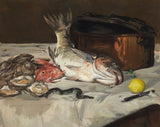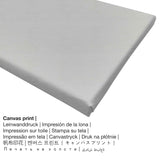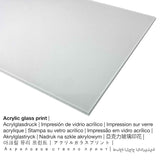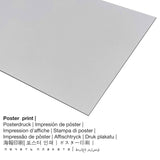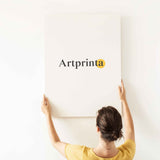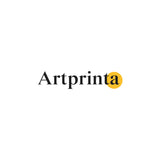Édouard Manet, 1864 - Azụ (Ndụ ka dị) - mbipụta nka mara mma
Ụtụ gụnyere. Mbupu gbakọrọ na ndenye ọpụpụ.
Ngwa ihe ị nwere ike họrọ:
The product dropdown list ofers you the chance to select a material and a size of your choice. The following options are available for individualization:
- Glass acrylic e biri ebi (nwere ezigbo mkpuchi iko): A glossy print on acrylic glass, often referred to as a plexiglass print, will transform your favorite artwork into gorgeous home decoration. The work of art is being manufactured thanks to the help of state-of-the-art UV printing technology. With a glossy acrylic glass art print contrasts and also artwork details will be more identifiable thanks to the precise gradation of the print.
- Mbipụta nke aluminom: An Aluminium Dibond print is a print material with a true depth. Its non-reflective surface creates a modern look. The Direct Print on Aluminum Dibond is your perfect start to art reproductions with aluminum. Colors are luminous in the highest definition, details appear crisp and clear, and you can really perceive a matte appearance of the print.
- Mbipụta kwaaji: A printed canvas, which should not be mistaken with a painting on a canvas, is a digital copy printed onto cotton canvas material. How can I hang a canvas print on the wall? Canvas prints are relatively low in weight, meaning that it is easy to hang the Canvas print without the support of additional wall-mounts. A canvas print is suited for all kinds of walls.
- Mpempe akwụkwọ mmado ebipụtara na akwa akwa: The Artprinta poster is a printed flat canvas paper with a granular surface finish, which resembles the original masterpiece. It is appropriate for placing your art replica with a special frame. Please keep in mind, that depending on the size of the poster print we add a white margin of around 2-6 cm round about the print motif to facilitate the framing with a custom frame.
Nkwupụta iwu: We try our utmost in order to describe our art products as accurate as possible and to demonstrate them visually on the various product detail pages. However, the colors of the print products and the printing can vary marginally from the presentation on the monitor. Depending on the screen settings and the quality of the surface, not all color pigments are printed 100% realistically. Considering that all our art prints are processed and printed manually, there might as well be minor discrepancies in the exact position and the size of the motif.
Nkọwa ihe osise izizi sitere na Art Institute Chicago (© Nwebiisinka - nke Art Institute Chicago - Ụlọ ọrụ Art Chicago)
Although still-life ensembles were an important element in many of the major paintings of the avant-garde artist Édouard Manet, his most sustained interest in the genre itself was from 1864 to 1865, when Fish was painted. Manet’s focus on still lifes coincided with the gradual reacceptance of the genre during the nineteenth century, due in part to the growth of the middle class, whose tastes ran to intimate, moderately priced works. This painting, like many of Manet’s still-life compositions, recalls seventeenth-century Dutch models. The directness of execution, bold brushwork, and immediacy of vision displayed in the canvas, however, suggest why the public found Manet’s work so unorthodox and confrontational. While Fish is indeed an image of “dead nature” (nature morte is the French term for still life), there is nothing still about the work: the produce seems fresh and the handling of paint vigorous. Further enliven-ing the composition is the placement of the carp, which offsets the strong diagonal of the other elements. Manet never submitted his still lifes to the official French Salon but rather sold them through the burgeoning network of art galleries in Paris and gave them to friends.
Product ọmụma
The over 150 year-old masterpiece was painted by the realist painter Edouard Manet. A na-ese ihe mbụ nke ihe osise ahụ na nha: 73,5 × 92,4 cm (28 15/16 × 36 3/8 na) e tekwara ya na ọkara mmanụ na kwaaji. "Signed lower right: Manet" is the painting's original inscription. Nowadays, the artpiece belongs to the Ụlọ ọrụ Art nke Chicago collection, which is one of the world’s great art museums, housing a collection that spans centuries and the globe. This modern art artpiece, which belongs to the ngalaba ọha is being included with courtesy of Art Institute Chicago. Moreover, the artwork has the creditline: Mr. and Mrs. Lewis Larned Coburn Memorial Collection. Furthermore, alignment of the digital reproduction is landscape and has a side ratio of 1.2: 1, meaning that the length is 20% longer than the width. Édouard Manet was a painter of French nationality, whose style can mainly be assigned to Realism. The French artist lived for a total of 51 afọ a mụrụ na 1832 ma nwụọ n'afọ 1883 na 8th arrondissement nke Paris.
Ozi ndabere na mpempe nka
| Akụkụ nka: | "Fish (Still Life)" |
| Nhazi: | sere |
| Okwu nche anwụ: | nkà nke oge a |
| Century: | 19th narị afọ |
| Afọ okike: | 1864 |
| Afọ nka: | ihe karịrị afọ 150 |
| Usoro nka izizi: | mmanụ na kwaaji |
| Nha nke ihe nka izizi: | 73,5 × 92,4 cm (28 15/16 × 36 3/8 na) |
| Akara aka na nka nka: | signed lower right: Manet |
| Egosiputara na: | Ụlọ ọrụ Art Chicago |
| Ebe ngosi nka: | Chicago, Illinois, Njikota Obodo Amerika |
| ibe weebụ nke Museum: | www.artic.edu |
| Ụdị nka nka: | ngalaba ọha |
| Site n'aka: | Ụlọ ọrụ Art Chicago |
| Ebe E Si Nweta: | Mazị na Oriakụ Lewis Larned Coburn mkpokọta ncheta |
Ngwaahịa a
| Nkewa edemede: | ọmarịcha nka |
| Usoro mmeputakwa: | dijitalụ mmeputakwa |
| Production usoro: | Mbipụta UV ozugbo |
| Nlụpụta: | German mmepụta |
| Ụdị ngwaahịa: | a na-achọ |
| Eji ngwaahịa a chọrọ: | nchịkọta nka (mmeputakwa), ụlọ ọrụ mbipụta nka |
| Ndozi onyonyo a: | nhazi odida obodo |
| Oke akụkụ: | (ogologo: obosara) 1.2: 1 |
| Mmetụta nke oke akụkụ: | ogologo bụ 20% ogologo karịa obosara |
| Ụdị dị iche iche dị: | Mpempe akwụkwọ, akwụkwọ mmado (akwụkwọ akpa), mbipụta enyo acrylic (nwere ezigbo mkpuchi iko), mbipụta ọla (aluminium dibbond) |
| Mbipụta kanvas (akwa akwa na etiti ihe ndọtị) dị iche iche: | 60x50cm - 24x20", 120x100cm - 47x39", 180x150cm - 71x59" |
| Mpempe iko acrylic (nwere ezigbo mkpuchi iko) nha: | 60x50cm - 24x20", 120x100cm - 47x39", 180x150cm - 71x59" |
| Ụdị akwụkwọ mmado (akwụkwọ kwaaji) dị iche iche: | 60x50cm - 24x20", 120x100cm - 47x39" |
| Mbipụta aluminom: | 60x50cm - 24x20", 120x100cm - 47x39" |
| Nhazi mbipụta nka: | agunyeghi |
Banyere onye na-ese ihe
| aha: | Edouard Manet |
| okike onye nka: | nwoke |
| Nationality: | French |
| Ọrụ onye na-ese ihe: | onye na-ese ihe |
| Mba onye si: | France |
| Nhazi nke onye nka: | omenkà nke oge a |
| Ụdị nka: | Ihe ngosi |
| Akwụsị: | 51 afọ |
| Amụrụ n'afọ: | 1832 |
| Nwụrụ n'afọ: | 1883 |
| Obodo ọnwụ: | 8th arrondissement nke Paris |
Edochiri ederede a site na nwebiisinka © | Artprinta.com

